interior lights PORSCHE CAYNNE 2010 1.G Owners Manual
[x] Cancel search | Manufacturer: PORSCHE, Model Year: 2010, Model line: CAYENNE, Model: PORSCHE CAYENNE 2010 1.GPages: 379, PDF Size: 13.91 MB
Page 4 of 379

4Dear Porsche OwnerA lot has gone into the manufacture of your
Porsche, including advanced engineering, rigid
quality control and demanding inspections. These
engineering and safety features will be enhanced
by you...the safe driver...– who knows her/his car and all controls,
– who maintains the vehicle properly,
– who uses driving skills wisely and always
drives within her/his own capabilities and the
level of familiarity with the vehicle.
You will find helpful hints in this manual on how to
perform most of the checks listed on the following
pages. If in doubt, have these checks performed
by your authorized Porsche dealer.
Before driving off...Check the following items firstfTurn the engine off before you attempt any
checks or repairs on the vehicle.
fBe sure the tires are inflated correctly.
Check tires for damage and tire wear.
fSee that wheel bolts are properly tightened
and not loose or missing.
fCheck engine oil level, add if necessary. Make
it a habit to have engine oil checked with every
refueling.
fCheck all fluid levels such as windshield
washer and brake fluid levels.
fBe sure the vehicle battery is well charged and
cranks the engine properly.
fCheck all doors and lids for proper operation
and latch them properly.
fCheck and if necessary replace worn or
cracked wiper blades.
fSee that all windows are clear and unobst-
ructed.
fCheck air intake slots and area between en-
gine compartment lid and windshield. Ensure
that these areas are free of snow and ice, so
the heater and the windshield wipers work
properly.fIf a child will be riding in the vehicle, check
child seat/child seat restraint system to ensure
that restraints are properly adjusted.
fCheck all exterior and interior lights for opera-
tion and that the lenses are clean.
fCheck the headlights for proper aim, and if
necessary, have them adjusted.
fCheck under the vehicle for leaks.
fBe sure all luggage is stowed securely.
Emergency equipmentIt is good practice to carry emergency equipment
in your vehicle.
Some of the items you should have are: window
scraper, snow brush, container or bag of sand or
salt, emergency light, small shovel, first-aid kit,
etc.
10_Cayenne_21_KW17.book Seite 4 Donnerstag, 9. April 2009 3:33 15
Page 7 of 379
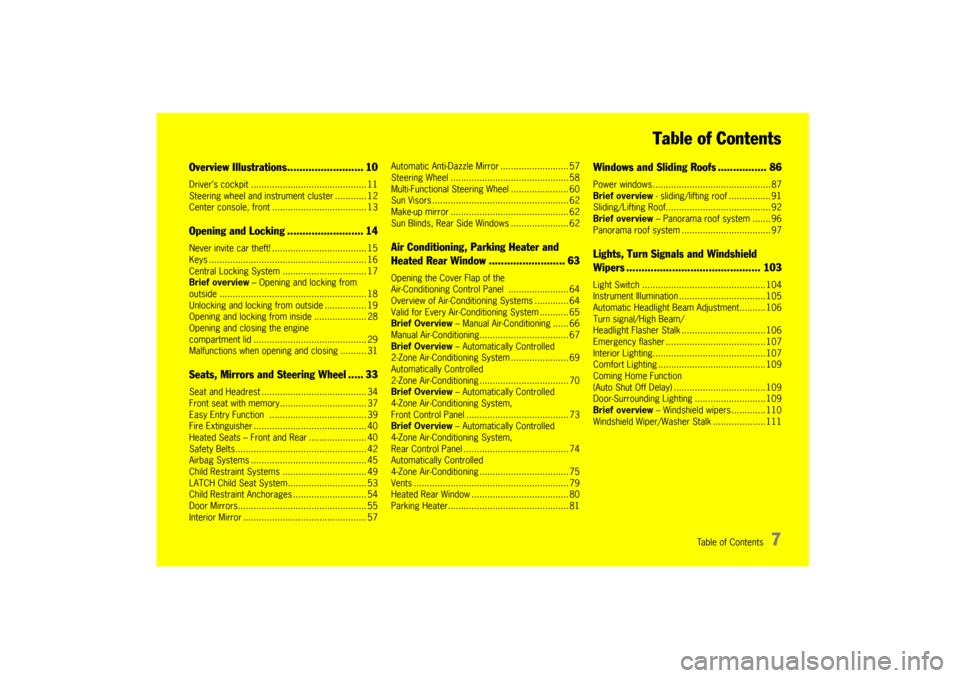
Table of Contents
7 Table of Contents
Overview Illustrations......................... 10Driver’s cockpit ............................................ 11
Steering wheel and instrument cluster ............ 12
Center console, front .................................... 13Opening and Locking ......................... 14Never invite car theft! .................................... 15
Keys ............................................................ 16
Central Locking System................................ 17
Brief overview – Opening and locking from
outside ........................................................ 18
Unlocking and locking from outside ................ 19
Opening and locking from inside .................... 28
Opening and closing the engine
compartment lid ........................................... 29
Malfunctions when opening and closing .......... 31Seats, Mirrors and Steering Wheel ..... 33Seat and Headrest ........................................ 34
Front seat with memory................................. 37
Easy Entry Function ..................................... 39
Fire Extinguisher ........................................... 40
Heated Seats – Front and Rear ...................... 40
Safety Belts.................................................. 42
Airbag Systems ............................................ 45
Child Restraint Systems ................................ 49
LATCH Child Seat System.............................. 53
Child Restraint Anchorages ............................ 54
Door Mirrors................................................. 55
Interior Mirror ............................................... 57Automatic Anti-Dazzle Mirror .......................... 57
Steering Wheel ............................................. 58
Multi-Functional Steering Wheel ...................... 60
Sun Visors .................................................... 62
Make-up mirror ............................................. 62
Sun Blinds, Rear Side Windows ...................... 62
Air Conditioning, Parking Heater and
Heated Rear Window ......................... 63Opening the Cover Flap of the
Air-Conditioning Control Panel ....................... 64
Overview of Air-Conditioning Systems ............. 64
Valid for Every Air-Conditioning System ........... 65
Brief Overview – Manual Air-Conditioning ...... 66
Manual Air-Conditioning.................................. 67
Brief Overview – Automatically Controlled
2-Zone Air-Conditioning System ...................... 69
Automatically Controlled
2-Zone Air-Conditioning .................................. 70
Brief Overview – Automatically Controlled
4-Zone Air-Conditioning System,
Front Control Panel ....................................... 73
Brief Overview – Automatically Controlled
4-Zone Air-Conditioning System,
Rear Control Panel ........................................ 74
Automatically Controlled
4-Zone Air-Conditioning .................................. 75
Vents ........................................................... 79
Heated Rear Window ..................................... 80
Parking Heater.............................................. 81
Windows and Sliding Roofs ................ 86Power windows ............................................. 87
Brief overview - sliding/lifting roof ................ 91
Sliding/Lifting Roof........................................ 92
Brief overview – Panorama roof system ....... 96
Panorama roof system.................................. 97Lights, Turn Signals and Windshield
Wipers ............................................ 103Light Switch ............................................... 104
Instrument Illumination................................. 105
Automatic Headlight Beam Adjustment.......... 106
Turn signal/High Beam/
Headlight Flasher Stalk ................................ 106
Emergency flasher ...................................... 107
Interior Lighting........................................... 107
Comfort Lighting ......................................... 109
Coming Home Function
(Auto Shut Off Delay)................................... 109
Door-Surrounding Lighting ........................... 109
Brief overview – Windshield wipers ............. 110
Windshield Wiper/Washer Stalk .................... 111
10_Cayenne_21_KW17.book Seite 7 Donnerstag, 9. April 2009 3:33 15
Page 57 of 379

Seats, Mirrors and Steering Wheel
57
Interior MirrorInitial position – lever forward
Anti-dazzle setting – lever back
Note on operation
fWhen the interior mirror is being adjusted, anti-
dazzle lever A must point forward.
E- Light-emitting diodes (LED)
F- Button for automatic anti-dazzle operation
G- Light sensorsAutomatic Anti-Dazzle MirrorSensors on the front and rear sides of the interior
mirror measure the incident light. The mirrors
automatically change to anti-dazzle position or
revert to their normal state, depending on the light
intensity.
Note on operation
The incident light in the area of light sensors G
must not be restricted (e.g. by stickers on the
windshield).Switching off automatic anti-dazzle
operation
fPress button F.
Light-emitting diode E goes out.
Note on operation
Anti-dazzle operation switches off automatically,
if:
– Reverse gear is engaged or
– Interior lighting and/or
reading lights in the front are switched on.
Switching on automatic anti-dazzle
operation
fPress button F.
Light-emitting diode E lights up.
Warning!
Danger of injury. Electrolyte fluid can
emerge from broken mirror glass. This fluid
irritates the skin and eyes.
fIf the electrolyte fluid should come into contact
with the skin or eyes, immediately rinse it off
with clean water.
See a doctor if necessary.
Risk of damage to paintwork and leather and
plastic parts, and clothing. Electrolyte fluid
can be removed only while it is still wet.
fClean the affected parts with water.
10_Cayenne_21_KW17.book Seite 57 Donnerstag, 9. April 2009 3:33 15
Page 68 of 379
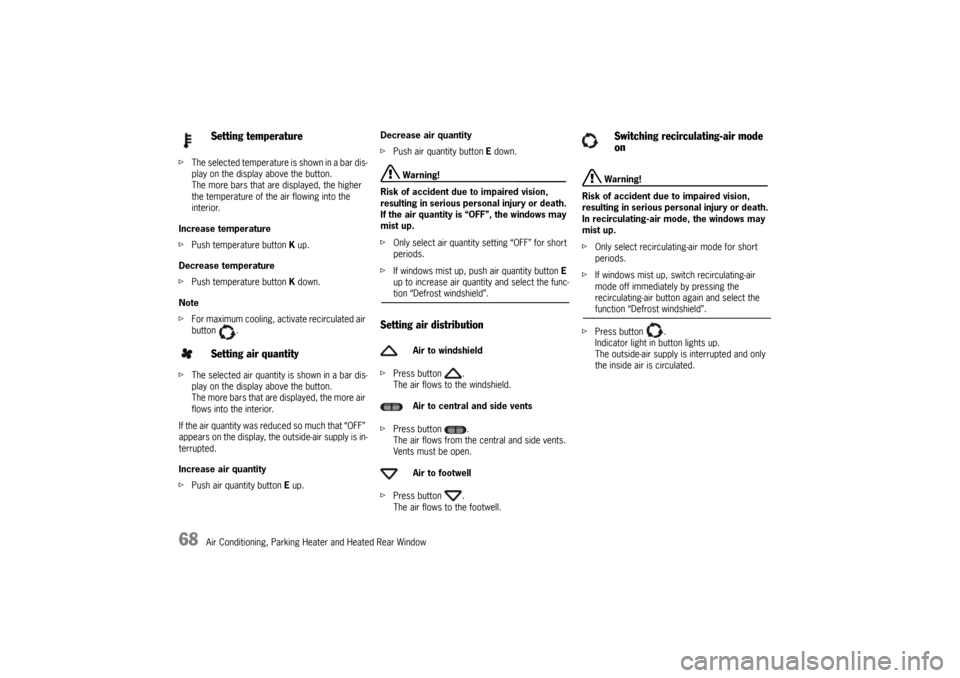
68
Air Conditioning, Parking Heater and Heated Rear Window fThe selected temperature is shown in a bar dis-
play on the display above the button.
The more bars that are displayed, the higher
the temperature of the air flowing into the
interior.
Increase temperature
fPush temperature button K up.
Decrease temperature
fPush temperature button K down.
Note
fFor maximum cooling, activate recirculated air
button .
fThe selected air quantity is shown in a bar dis-
play on the display above the button.
The more bars that are displayed, the more air
flows into the interior.
If the air quantity was reduced so much that “OFF”
appears on the display, the outside-air supply is in-
terrupted.
Increase air quantity
fPush air quantity button E up.Decrease air quantity
fPush air quantity button E down.
Warning!
Risk of accident due to impaired vision,
resulting in serious personal injury or death.
If the air quantity is “OFF”, the windows may
mist up.
fOnly select air quantity setting “OFF” for short
periods.
fIf windows mist up, push air quantity button E
up to increase air quantity and select the func-tion “Defrost windshield”.
Setting air distributionfPress button .
The air flows to the windshield.
fPress button .
The air flows from the central and side vents.
Vents must be open.
fPress button .
The air flows to the footwell.
Warning!
Risk of accident due to impaired vision,
resulting in serious personal injury or death.
In recirculating-air mode, the windows may
mist up.
fOnly select recirculating-air mode for short
periods.
fIf windows mist up, switch recirculating-air
mode off immediately by pressing the
recirculating-air button again and select the function “Defrost windshield”.
fPress button .
Indicator light in button lights up.
The outside-air supply is interrupted and only
the inside air is circulated.
Setting temperature
Setting air quantity
Air to windshield
Air to central and side vents
Air to footwell
Switching recirculating-air mode
on
10_Cayenne_21_KW17.book Seite 68 Donnerstag, 9. April 2009 3:33 15
Page 70 of 379

70
Air Conditioning, Parking Heater and Heated Rear Window
Automatically Controlled 2-Zone
Air-ConditioningDepending on various factors (e.g. sunlight, air
quality), the air-conditioning system controls the
preset interior temperature fully automatically.
Temperature can be set individually/separately for
the two left and right air-conditioned areas.
You can manually influence the automatic system.
This individual adjustment is shown on the
air-conditioning display panel.Please read the information on:
–REST mode,
–ECON mode and
– Air-conditioning compressor
on page 65.
Control panel
A- Windshield defroster
B-Heated rear window
C- AUTO button (automatic mode)
D- Recirculated air, automatic recirculated air
E- Air-conditioning display
F-Temperature sensor
G- Air-quantity button
H- Temperature button for left side
I- Air to windshield
J- Air to footwell
K- Air to central and side vents
L- ECON button (air-conditioning compressor off/on)
M- REST button (engine residual heat)
N- Temperature button, right sidefPress button .
Indicator light in button lights up.
The air flows to the windshield and the front
side windows.
The windshield is demisted or defrosted as
quickly as possible.
Ending the function
fPress button again or
fPress button .
Defrosting the windshield
10_Cayenne_21_KW17.book Seite 70 Donnerstag, 9. April 2009 3:33 15
Page 71 of 379

Air Conditioning, Parking Heater and Heated Rear Window
71
Automatic modefPress button .
Indicator light in button lights up.
Air quantity and air distribution are automati-
cally controlled and variations are compensa-
ted.
Note on operation
If necessary, the automatic system can be manu-
ally influenced.
This manual setting is retained until the appropri-
ate function button is pressed again or the button
is pressed.SensorsTo avoid affecting the performance of the air-con-
ditioning system:
fDo not cover the sun sensor on the dashboard
and the temperature sensor F in the front con-
trol panel of the air-conditioning system.
Setting temperatureTo suit personal comfort, the interior temperature
can be adjusted between 61 °F and 85 °F (16 °C
and 29.5 °C).
Recommendation: 72 °F (22 °C)
The selected temperature is shown on the display
above the button.
Increase temperature
fPush temperature button up.
Left side of vehicle: button H
Right side of vehicle: button N
Decrease temperature
fPush temperature button down.
Left side of vehicle: button H
Right side of vehicle: button N
If “LO” or “HI” appears on the display, the system
is operating at maximum cooling or heating
power. Automatic mode is switched off.
If the preselected temperature is changed, the air
quantity blowing out can adjust automatically in
automatic mode.
The desired temperature is reached more quickly
this way.The selected air quantity is shown in a bar display
on the display above the button.
The more bars that are displayed, the more air
flows into the interior.
Increase air quantity
fPush air quantity button G up.
Decrease air quantity
fPush air quantity button G down.
Press button to return to automatic mode.
If the air quantity was reduced so much that “OFF”
appears on the display, the outside-air supply is
interrupted.
Warning!
Risk of accident due to impaired vision,
resulting in serious personal injury or death.
If the air quantity is “OFF”, the windows may
mist up.
fOnly select air quantity setting “OFF” for short
periods.
fIf windows mist up, push air quantity button G
up to increase air quantity and select the func-tion “Defrost windshield”.
Setting air quantity
10_Cayenne_21_KW17.book Seite 71 Donnerstag, 9. April 2009 3:33 15
Page 75 of 379

Air Conditioning, Parking Heater and Heated Rear Window
75
Automatically Controlled 4-Zone
Air-ConditioningDepending on various factors (e.g. ambient tem-
perature, sunlight, air quality), the air-conditioning
system controls the preset interior temperature
fully automatically.
Temperature, air quantity and air distribution can
be set individually/separately for the four air-con-
ditioned areas front left, front right, rear left and
rear right.
You can manually influence the automatic system.
This individual adjustment is shown on the
air-conditioning display panel.Please read the information on:
–REST mode,
–ECON mode and
– air-conditioning compressor
on page 65.
Control panel, front
A- Windshield defroster
B-Heated rear window
C- AUTO button (automatic mode)
REST button (engine residual heat)
D- Recirculated air, automatic recirculated air
E- Air-conditioning display
F-Temperature sensor
G- Air-quantity button, left
H-Temperature button, left
I- Air to windshield, left
J- Air to footwell, left
K- Air to left central and side vents
L- Setting for rear air-conditioned areas
M- ECON button (air-conditioning compressor off/on)
N- Air to right central and side vents
O- Air to footwell, right
P- Air to windshield, right
Q- Temperature button, right
R- Air-quantity button, rightfPress button on the front control panel.
Indicator light lights up.
The air flows to the windshield and the front
side windows.
The windshield is demisted or defrosted as
quickly as possible.
Ending the function
fPress button again or
fPress the button .
Defrosting the windshield
10_Cayenne_21_KW17.book Seite 75 Donnerstag, 9. April 2009 3:33 15
Page 103 of 379
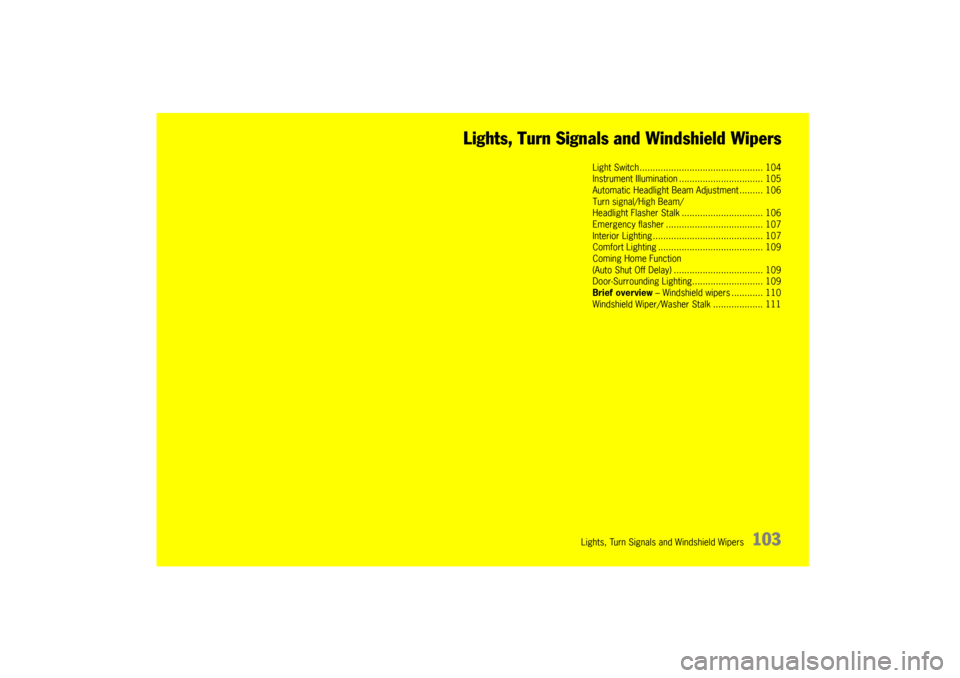
Lights, Turn Signals and Windshield Wipers
103 Lights, Turn Signals and Windshield Wipers
Light Switch ............................................... 104
Instrument Illumination................................ 105
Automatic Headlight Beam Adjustment ......... 106
Turn signal/High Beam/
Headlight Flasher Stalk ............................... 106
Emergency flasher ..................................... 107
Interior Lighting .......................................... 107
Comfort Lighting ........................................ 109
Coming Home Function
(Auto Shut Off Delay).................................. 109
Door-Surrounding Lighting........................... 109
Brief overview – Windshield wipers ............ 110
Windshield Wiper/Washer Stalk ................... 111
10_Cayenne_21_KW17.book Seite 103 Donnerstag, 9. April 2009 3:33 15
Page 105 of 379
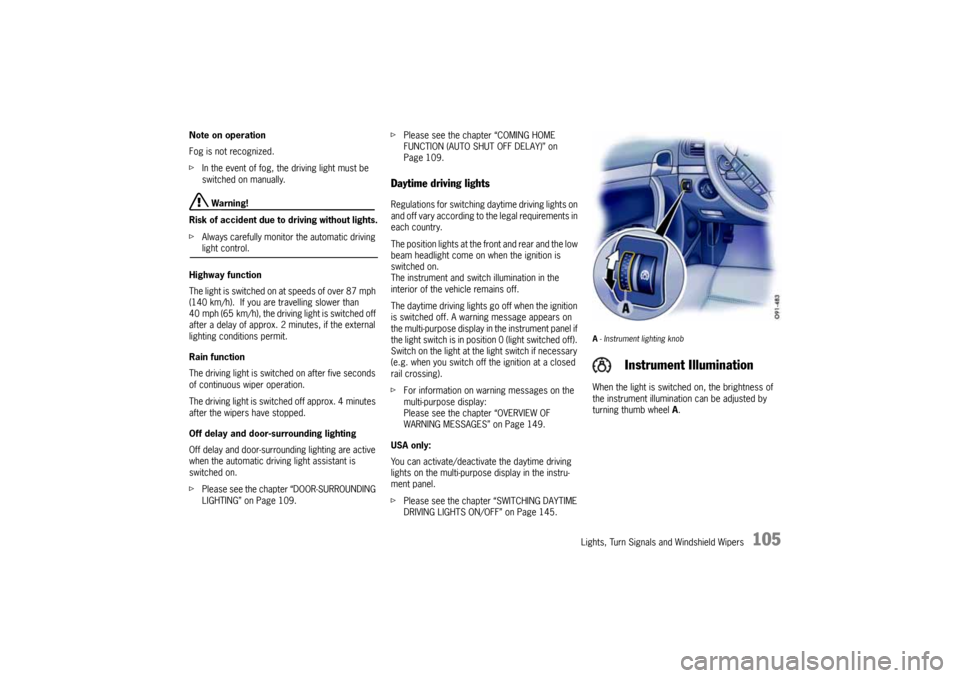
Lights, Turn Signals and Windshield Wipers
105
Note on operation
Fog is not recognized.
fIn the event of fog, the driving light must be
switched on manually.
Warning!
Risk of accident due to driving without lights.
fAlways carefully monitor the automatic driving light control.
Highway function
The light is switched on at speeds of over 87 mph
(140 km/h). If you are travelling slower than
40 mph (65 km/h), the driving light is switched off
after a delay of approx. 2 minutes, if the external
lighting conditions permit.
Rain function
The driving light is switched on after five seconds
of continuous wiper operation.
The driving light is switched off approx. 4 minutes
after the wipers have stopped.
Off delay and door-surrounding lighting
Off delay and door-surrounding lighting are active
when the automatic driving light assistant is
switched on.
fPlease see the chapter “DOOR-SURROUNDING
LIGHTING” on Page 109.fPlease see the chapter “COMING HOME
FUNCTION (AUTO SHUT OFF DELAY)” on
Page 109.
Daytime driving lightsRegulations for switching daytime driving lights on
and off vary according to the legal requirements in
each country.
The position lights at the front and rear and the low
beam headlight come on when the ignition is
switched on.
The instrument and switch illumination in the
interior of the vehicle remains off.
The daytime driving lights go off when the ignition
is switched off. A warning message appears on
the multi-purpose display in the instrument panel if
the light switch is in position 0 (light switched off).
Switch on the light at the light switch if necessary
(e.g. when you switch off the ignition at a closed
rail crossing).
fFor information on warning messages on the
multi-purpose display:
Please see the chapter “OVERVIEW OF
WARNING MESSAGES” on Page 149.
USA only:
You can activate/deactivate the daytime driving
lights on the multi-purpose display in the instru-
ment panel.
fPlease see the chapter “SWITCHING DAYTIME
DRIVING LIGHTS ON/OFF” on Page 145.
A- Instrument lighting knobWhen the light is switched on, the brightness of
the instrument illumination can be adjusted by
turning thumb wheel A.
Instrument Illumination
10_Cayenne_21_KW17.book Seite 105 Donnerstag, 9. April 2009 3:33 15
Page 107 of 379
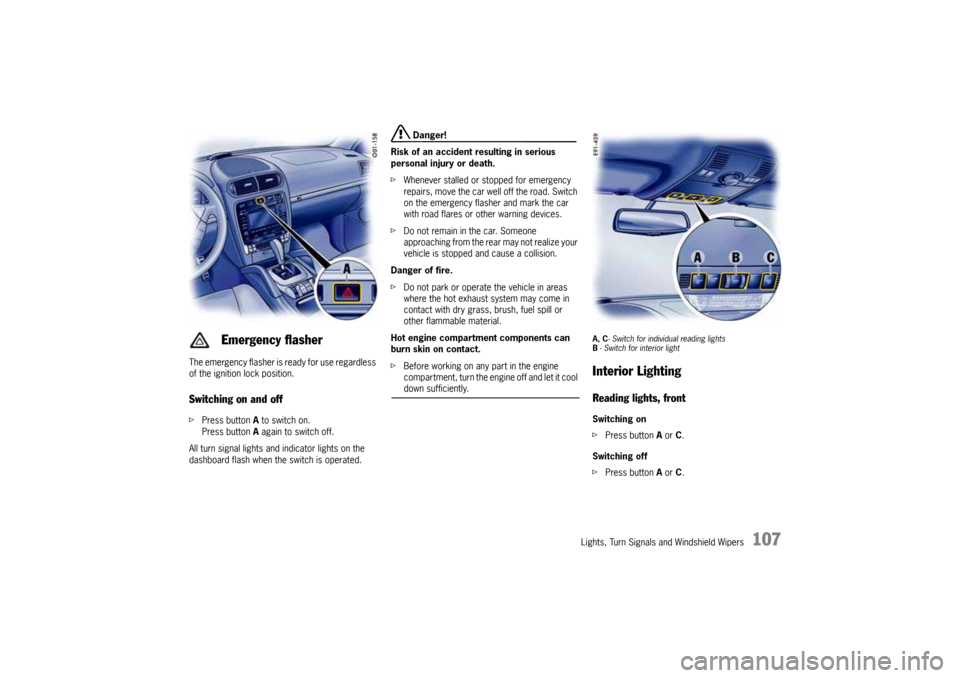
Lights, Turn Signals and Windshield Wipers
107
The emergency flasher is ready for use regardless
of the ignition lock position.Switching on and offfPress button A to switch on.
Press button A again to switch off.
All turn signal lights and indicator lights on the
dashboard flash when the switch is operated.
Danger!
Risk of an accident resulting in serious
personal injury or death.
fWhenever stalled or stopped for emergency
repairs, move the car well off the road. Switch
on the emergency flasher and mark the car
with road flares or other warning devices.
fDo not remain in the car. Someone
approaching from the rear may not realize your
vehicle is stopped and cause a collision.
Danger of fire.
fDo not park or operate the vehicle in areas
where the hot exhaust system may come in
contact with dry grass, brush, fuel spill or
other flammable material.
Hot engine compartment components can
burn skin on contact.
fBefore working on any part in the engine
compartment, turn the engine off and let it cool down sufficiently.
A, C- Switch for individual reading lights
B- Switch for interior lightInterior LightingReading lights, frontSwitching on
fPress button A or C.
Switching off
fPress button A or C.
Emergency flasher
10_Cayenne_21_KW17.book Seite 107 Donnerstag, 9. April 2009 3:33 15